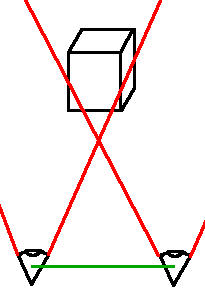|
Stereograms have been a thing of intrigue since the advent of photography and became a cultural phenomenon in the early 1990s with the "Magic Eye" posters and books. However, what you may not know is that creating stereograms is incredibly simple -- all you need is a camera (either film or digital) with enough storage to hold two pictures. The key to creating a stereogram lies in the observation we can make from the diagram below.
 In the diagram we see two eyes with their respective fields of vision denoted by the red lines. If the two eyes were directly on top of each other, their fields of vision would be exactly the same. However, some distance (the green line) separates the two eyes which produces two similar, yet distinct, fields of vision. The key in the creation of a stereogram lies in capturing these two fields of vision by taking two pictures from the vantage point of each eye. Sounds simple? Well, it is!
In the diagram we see two eyes with their respective fields of vision denoted by the red lines. If the two eyes were directly on top of each other, their fields of vision would be exactly the same. However, some distance (the green line) separates the two eyes which produces two similar, yet distinct, fields of vision. The key in the creation of a stereogram lies in capturing these two fields of vision by taking two pictures from the vantage point of each eye. Sounds simple? Well, it is!
Below is a cross-eye viewable stereogram of my living room. You can tell that the image on the right is what is to be viewed by the left eye by noticing that more of the bookshelf is visible. It can also be seen that the image on the left is to be viewed by the right eye due to the entire keyboard (which is on the right side of the image) being visible. Cross your eyes to view the scene in 3D.


The key in getting the photographs to turn out well is to refrain from changing the orientation of the camera while changing its position from eye to eye. A good way to do this is by placing the camera on a flat surface, taking the first photograph from the vantage of the right eye, and then sliding the camera over to your left eye without moving your head or rotating the camera. Such a technique was used to create the above stereogram using a normal digital camera without the aid of any special photographic equipment such as a tripod.
We close with a note on computer graphics. The same effect can be acheived by translating the camera over some distance to the left and to the right to render and/or capture each frame. This is precisely the technique involved when using shutter glasses to view a scene in 3D. The frame intended for the left eye is displayed while the right shutter is closed, and the frame intended for the right eye is displayed while the left shutter is closed. Sounds too simple? Well, it is!
Good luck creating stereograms of your own!
|



